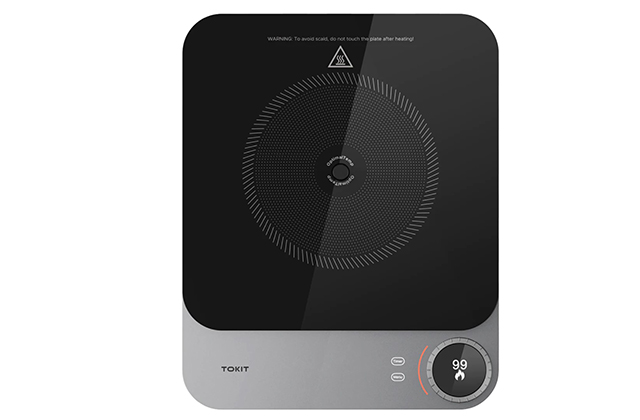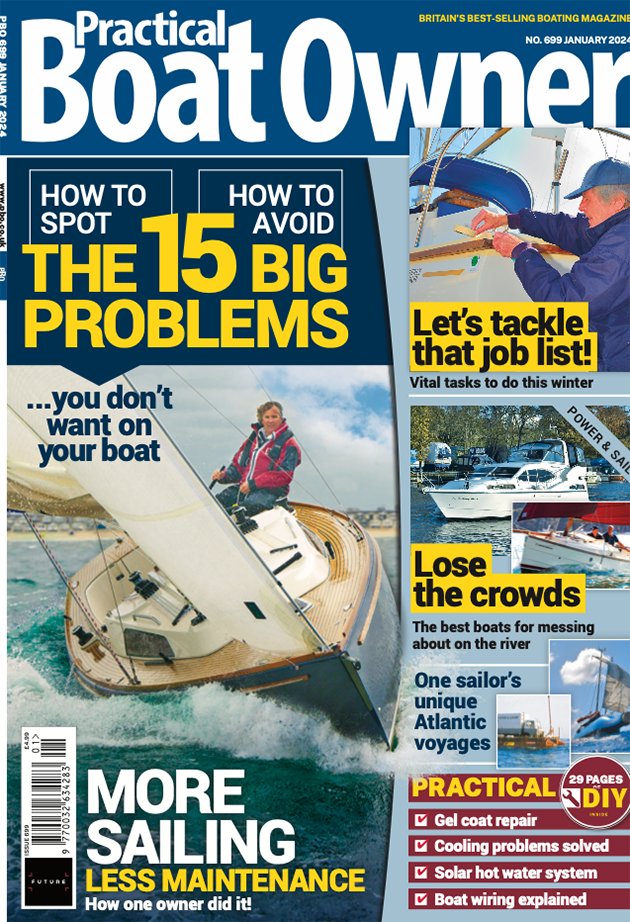So you're thinking of ditching that old gas cooker and trying some induction cooking? Here's what you need to know on power consumption and how to run one onboard your boat.
Maybe you want to augment your onboard facility with a neat portable induction cook top for when you’re on shore power or perhaps you want to go completely gas free and only cook with electric power.
The next burning question after what’s a good sized induction hob to cook with, is how do I power that thing?
Well, I have lived with an induction cook top for the past six years and have used it for food prep aboard my sail boat when going offshore for a few days or simply for a weekend. The induction cook top I use is a Tefal model shown below but most hob tops are a similar size and weight, varying a little on power.
My own boat doesn’t have the battery capacity to power one of these away from shore power, but then again, I barely have enough power to run my fridge so I’m running a lean machine. I can run mine onboard to save on expensive gas when I’m in a marina and have the luxury of shore power.
But let’s have a look at what exactly is needed if you want to go off grid, unhook and go all in, electric.
Most models of induction cooktop offer up to 2kw max power, but you’ll rarely use this unless you turn it to max heat setting. The more sophisticated your induction cooktop, the finer the power increase between heat level settings.

The Tefal model I have has 9 manual heat settings. I never bother with the preset options as I want to retain better control over my cooking. I have measured the power used for each setting. For the first 3 heat settings it uses 850 watts but clicks in and out to reduce the heat. For example at heat setting one, I can hear it click on and off with a second or two between each click, essentially only being “on” for 30 seconds out of every minute. On the heat level two it clicks on and off more frequently and then at the 3rd heat level it is pretty much on most of the time, just occasionally clicking off.
Buckle up Induction Cooking fans, we’re about to get numbers heavy
The fan on the Tefal, which is running all of the time uses a modest 7w.
I cook virtually everything on heat level 3. Occasionally 4 and 2. Bringing a large pan to the boil might be on max heat for around two minutes and then drop back to heat level 3.
The amount of battery power required to cook, say a stir fry, which will see the cooktop switched on for 25 minutes, using level 3 heat setting for the whole time. Accounting for additional losses through inverter inefficiency, you’re likely to use about 30 amps from a 12v battery bank or 15amps from a 24v battery bank.
A typical battery bank of most yachts is between 220Ah and 600Ah. If we assume these to be AGM or flooded lead acid, then we immediately halve that number to see what usable power we have. For Lithium batteries we get closer to 90-95% usable capacity.
Let’s have a look at battery bank sizes and how much useable power you can expect from them before the voltage drops below our inverter safety threshold:
| Battery bank size | AGM/flooded theoretical usable Ah |
AGM/flooded realistic usable Ah |
Lithium theoretical usable Ah |
|---|---|---|---|
| 110Ah | 55 | 30 | 105 |
| 220Ah | 110 | 65 | 205 |
| 330Ah | 165 | 95 | 310 |
| 440Ah | 220 | 120 | 420 |
| 550Ah | 275 | 180 | 525 |
| 660Ah | 330 | 240 | 635 |
Now let’s have a look at how much a standard induction hob will use from your battery bank. This is all theoretical. Real world use will require us to account for some losses from our inverter, 24v volts inverted to 110v is less “lossy” than say 12v to 240v which requires a bigger step up which will result in some power losses in the conversion process. We also need to take into account the ability of a larger battery bank to withstand a higher voltage demand for a short amount of time, compared to a smaller battery which has higher resistance due to the lower capacity.
| 110v from 12V battery bank |
240v from 12v battery bank |
110v from 24v battery bank |
240v from 24v battery bank |
|
|---|---|---|---|---|
| 100w/2hrs | 17Ah | 17Ah | 8Ah | 8Ah |
| 500w/30mins | 21Ah | 21Ah | 10Ah | 10Ah |
| 850w/30 mins | 35Ah | 35Ah | 18Ah | 18Ah |
| 1000w/30 mins | 42Ah | 42Ah | 21Ah | 21Ah |
| 1500w/30mins | 63Ah | 63Ah | 31Ah | 31Ah |
| 2000w/30 mins | 83Ah | 83Ah | 42Ah | 42Ah |
| 2100w/2 mins | 6Ah | 6Ah | 3Ah | 3Ah |
Example, if you have a battery bank of just 220Ah AGM, 12v inverted to 240v and you want to boil a pan of water for 2 minutes at 2100w… You’re likely to use more like 8 or 9Ah due to the losses incurred with the high power step up and the large power draw.
Alternatively a large capacity battery bank will have much lower resistance and can support short bursts of high drain much more easily. A battery bank of 660Ah, running at 24v inverted to 110V is more likely to use 3 or 4Ah to boil a pan of water.
In answer to the question, how big a battery bank do I need? The bigger the better, but Lithium is currently best as it gives a much higher efficiency per Ah.
A 24v, 300-400Ah Lithium set up, if you have pockets deep enough would be absolutely champion for off grid living. But you can manage with 440Ah AGM and a smaller capacity Lithium at 150Ah usable. Just use it wisely and be ready with some method or recharging your battery bank to avoid over draining your power storage, whichever you choose.
Don’t forget your solar chargers, wind chargers and hydro chargers to keep tip top while you’re sailing/moving.
Buyers guide:

Tefal Everyday Induction Portable Hob
Specifications: Integrated timer, 6 pre-set functions, 9 power levels from 450W to 2100W, Dimensions: 13.46 x 10.87 x 2.2 cm, weight: 2.51kg
Reasons to Buy: Easy to clean, easy to use, easy to stow
Reasons to Avoid: The induction noise can be annoying for some, fan can sometimes make a bit of a noise if it gets dirty/out of balance.
I’ve used this Induction hob nearly every day for the past 6 years. It’s a staple item in my shore based food prep galley and is easily transported to and from my boat or is useful when camping with mains power. Initially the sound of the induction clicking on and off and the high pitched noise it makes when powering up on the higher settings can be a bit annoying, but I soon go used to it. That or I’ve gone a bit deaf over the years. The fan annoys me with the amount of time it runs after turning the hob off, but that’s minor really compared to the speed and ease of using it. It wipes clean easily too. At 2.5kg it is the second lightest out of these four models I have picked out for you.
Out of the line up this one has the fewest heat level options at just 9.
Beware, and this applies to every induction hob in this guide, that the size of pan on top can be limited. If you have a large frying pan for example, it can interfere with the buttons or power settings and it might not heat up evenly. The optimum sized pan for most of these induction cook tops is around 18-24cm.

TOKIT Portable Induction Hob Pro
Specifications: Dimensions: 35 x 28 x 2 cm; Weight: 2.89kg, 99 heat levels
Reasons to Buy: Slim and very easy to stow, quieter than some other models, very low power option allows for slow cooking.
Reasons to Avoid: This is the highest priced model in this line up.
TOKIT, the brand, was crowdfunded in 2021 when the founders wanted to make a smart all-in-one cooker. The company expansion resulted in this induction hob.
If you’re not much of a cook, then it has some in-built programming for automatic cooking which can make it rather more efficient. It also has one of the lowest power setting options of all of the induction hobs available here. I especially like the power dial allowing fine tuning for cooking. Though in reality it works in power bands like many others and just clicks in and out to fine tune the power at a given level. The lowest 100w setting is ideal for slow cooking and energy efficiency.

Caterlite Induction Hob
Specifications: Dimensions 4.5 x 29.5 x 37 cm, Weight 2.6kg, 10 power settings, 2000w
Reasons to Buy: Great price point, simple and easy to use, can set by temperature or power level.
Reasons to Avoid: No built in programming
The Caterlite is another budget friendly induction cooktop. It has power settings from 500w up to 2000w. For lower cooking heat levels it achieves this by turning off and on at the lowest power setting. It’s a slimline model though and fits easily into locker spaces.

IKEA TILLREDA PORTABLE INDUCTION HOB
Specifications: Dimensions 27 cm x 30.5 cm x 6.2 cm, weight: 2.40 kg, cord length: 140 cm, 10 power settings, 2000w
Reasons to Buy: Good value for money, simple to use, useful hanging loop and cord storage
Reasons to Avoid: It’s a little bit chunkier than others
The Tillreda was used in the recent PBO article, cooking onboard. It’s a simple and easy to use induction hob.
It’s a bit of a chunky model, but its simplicity and low price are appealing. The lowest setting uses 100w and steps up incrementally all the way to max power 2000w. This is achieved by clicking on and off at a higher wattage just like other portable induction hobs. The Tillreda has a nice little pause function, so you can pause the cooker and then resume cooking again. Ideal if the phone rings while you’re cooking and don’t want to burn your food while distracted.
Enjoyed reading Induction Cooking Onboard – The Essential Information? 
A subscription to Practical Boat Owner magazine costs around 40% less than the cover price.
Print and digital editions are available through Magazines Direct – where you can also find the latest deals.
PBO is packed with information to help you get the most from boat ownership – whether sail or power.
-
-
-
- Take your DIY skills to the next level with trusted advice on boat maintenance and repairs
- Impartial in-depth gear reviews
- Practical cruising tips for making the most of your time afloat
-
-





